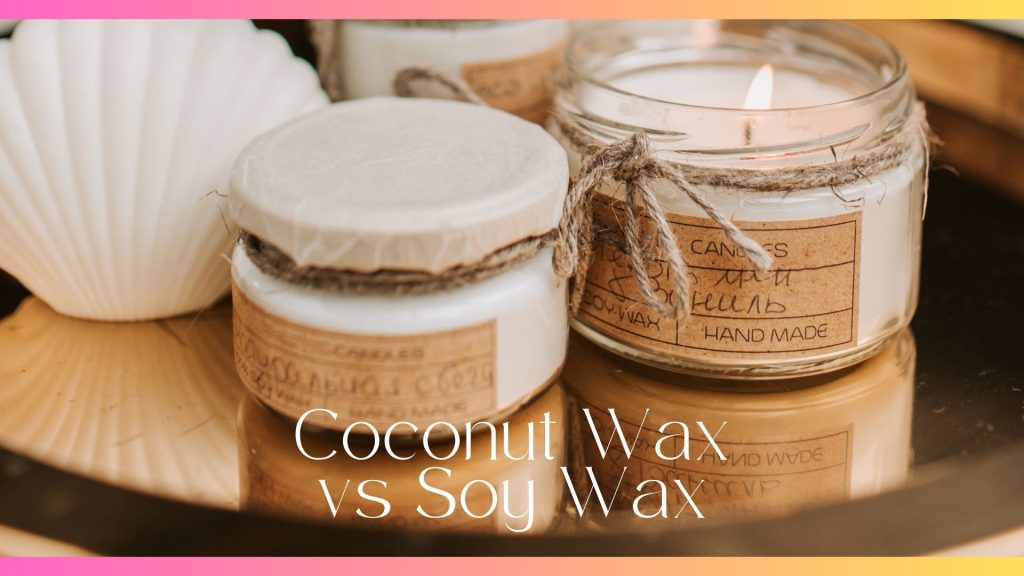Wondering how long do coconut wax candles need to cure? Don’t know if you’re doing things right? Here’s some things you should know!
Coconut wax candles have gained popularity in recent years, thanks to its eco-friendly properties. However, not all waxes are the same and that goes with how long they need to cure.
In this article, I’ll discuss everything you need to know about curing coconut wax candles!
Disclaimer: This post may contain affiliate links. This means I may earn a small commission (at no cost to you) if you sign up for a program or make a purchase using my link!
Related Posts:
- Soy Candles vs Coconut Candles for Candle-making
- How To Make Coconut Wax Candles with Essential Oils
- At What Temperature Does Candle Wax Melt?
What Is Candle Curing?
Candle curing is the process where the wax and fragrance molecules bind together to create a well-balanced, long-lasting scent. It’s even more important to do this for scented candles before using them.
It is a crucial step that helps ensure your candles burn evenly and that the fragrance will be fully developed and throw well when lit. Without proper curing, you might end up with candles that have a weak scent or burn unevenly, leading to a disappointing experience.
Why Do Candles Need to Cure?
There are a few reasons why candles need to cure, among them are:
- Enhances fragrance: It allows the fragrance oils to blend thoroughly with the wax, improving scent throw.
- Stabilizes wax: Helps the wax to fully harden, reducing the risk of cracking or melting unevenly during burning.
- Improves performance: Enables the candle to burn cleaner and longer, providing a more enjoyable and consistent experience for the candle user.
How Long Do Coconut Wax Candles Need to Cure?
When you pour a candle, especially one made from coconut wax, various chemical reactions begin and it continues to do so as the candle cools and solidifies for hours after.
Over time, the wax and fragrance oil continues to interact and stabilize. This should create a candle that performs well both in terms of burn quality and scent throw.
3 Factors Affecting Cure Time
Several factors can influence how long your coconut wax candles need to cure.
Here are a few factors you should know:
- Temperature and humidity: Ideally, you want to cure your candles in a cool, dry place. High temperatures or humidity can affect the wax and fragrance, potentially leading to issues like sweating or incomplete curing.
- Wax composition: Some coconut waxes may contain additives or be mixed with other types of wax, which can impact the curing time. Pure coconut wax often requires a longer curing period compared to blends.
- Fragrance load: Heavier fragrance loads typically need more time to fully integrate with the wax. Similarly, certain fragrance oils might take longer to stabilize.
Optimal Cure Time for Coconut Wax Candles
A good rule of thumb is to let your coconut candles cure for at least two weeks. This allows enough time for the fragrance and wax to fully bind together, ensuring a strong scent throw and an even burn.
You’ll know your candle is properly cured when the scent is robust and the wax is hard and smooth to the touch. Additionally, a well-cured candle will burn cleanly and evenly, without tunneling or excessive soot.
Tips for Properly Curing Coconut Wax Candles
It’s important to store your curing candles in a cool, dark place. Exposure to light and heat can interfere with the curing process. Generally, all kinds of candles should be stored in a cool place away from light and heat.
Make sure that the area is free from drafts and fluctuations in temperature – this can affect the wax. It’s best to check your candles periodically during the curing process.
Look for signs of sweating or frosting, which can indicate issues with temperature or humidity. Adjust your storage conditions as needed to ensure optimal curing.
3 Common Curing Issues & Solutions
Here are three issues you may face when curing your coconut wax candles.
- Incomplete curing: If your candle hasn’t cured properly, it might have a weak scent or burn unevenly. Just allow more time for curing or adjust the curing environment to be cooler and less humid.
- Uneven fragrance distribution: Sometimes, the fragrance might not distributed evenly throughout the wax due to an inconsistent stir when mixing the fragrance oil. Just be sure to mix well for an even scent.
- Frosting: Frosting is a common issue with natural waxes like coconut wax. It appears as a white, crystallized pattern on the surface of the candle. To minimize frosting, make sure to pour your candles at the right temperature and avoid rapid cooling.
While frosting doesn’t affect the performance of the candle, it can be aesthetically unpleasing for some – a challenge if you’re selling these candles.
Enhancing the Quality of Your Coconut Wax Candles
Want to enhance the quality of your coconut wax candles? Here are some things you can do!
- Use additives: Additives like stearic acid or vybar can be used to improve the texture and hardness of your coconut wax candles. They can also help reduce frosting and improve scent throw.
- Blend waxes: Blending coconut wax with other natural waxes, such as soy or beeswax, can enhance the performance and appearance of your candles.
- Choose the right fragrance: Some fragrance oils are specifically designed for use in candles and will perform better during the curing process. Look for high-quality, candle-safe fragrances for your coconut wax.
How To Cure a Candle The Right Way
Here are a few best practices to maintain when to cure candles the right way.
- Cooling period: Allow the candle to cool completely after pouring, typically for 24 to 48 hours.
- Storage: Store the candles in a cool, dry place away from direct sunlight and drafts.
- Ventilation: Leave the lids off to allow any excess moisture and potential off-gassing to dissipate.
- Labeling: Once cured, label the candles with the date poured and fragrance used for reference.
Do You Cure Candles with Lids On or Off?
The curing process typically involves allowing them to cool and harden completely after pouring and before use. Whether you decide to cure candles with lids on or off depends on the type of wax used and personal preference.
Curing with the lids on helps retain fragrance and prevents dust or debris from getting on the surface of the candle. But letting the candles cure without the lid allows excess moisture and any potential off-gassing to escape more easily – which should aid in the curing process.
Bottom Line
If you’re a new candle-maker, you might feel like you need to rush with the candle-making process. But it’s actually safer to take things slow and that involves letting your candles cure properly!
It’s best to only use your scented coconut wax candles after letting them cure for at least two weeks. You’ll get to enjoy a stronger scent and have a pleasant burning experience.
All the best!
Frequently Asked Questions (FAQs)
Candle wax generally takes about 24 hours to harden completely after pouring. This timeframe ensures that the wax solidifies evenly throughout, preventing issues like cracking or uneven melting during burning.
It’s recommended to let a candle cure for at least 2 weeks after pouring. This allows the wax to cool and harden fully, ensuring optimal burn performance and fragrance release. Longer curing times is even more beneficial for some wax types like coconut or soy to achieve the best results.
Coconut wax candles typically have a longer burn time compared to other wax types. On average, they can burn for approximately 40 to 50 hours or more, depending on factors like candle size, fragrance load, and burning conditions. This longer burn time is due to coconut wax’s ability to burn more slowly and evenly, providing extended enjoyment of the candle.


